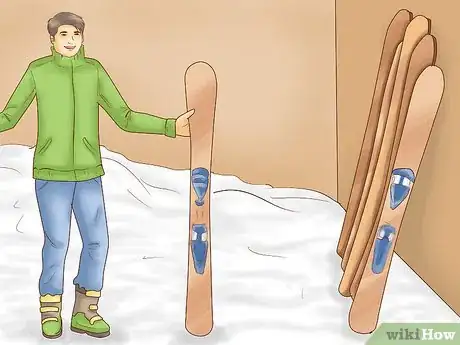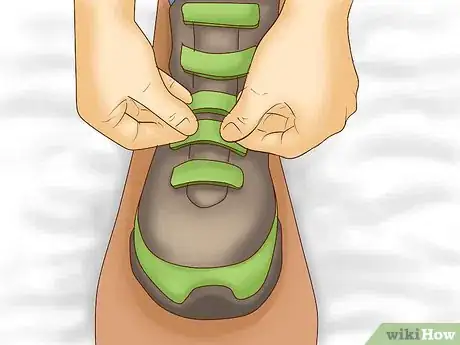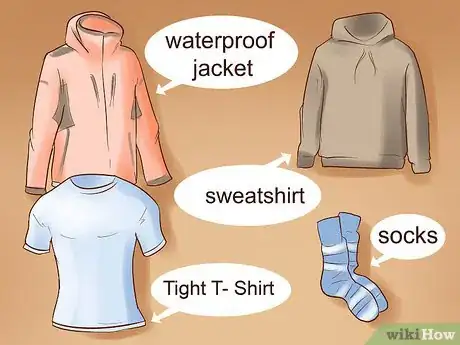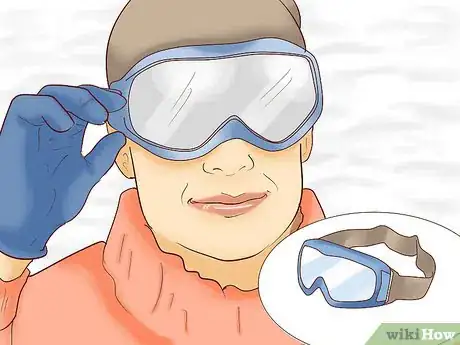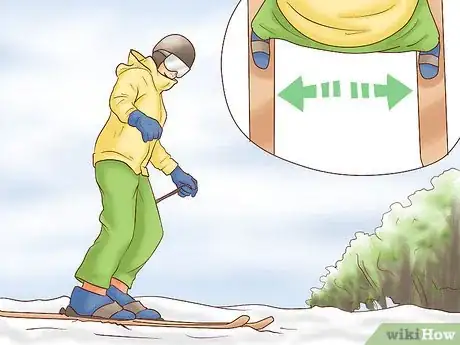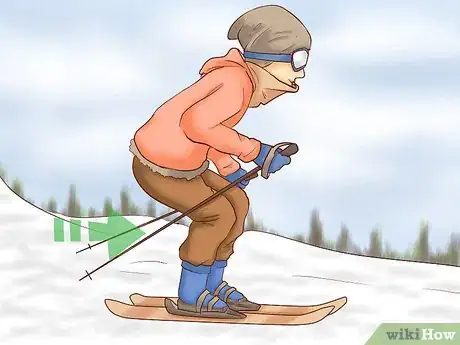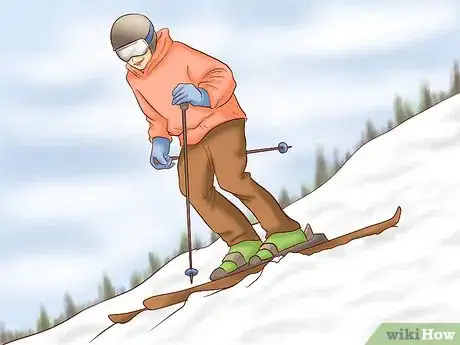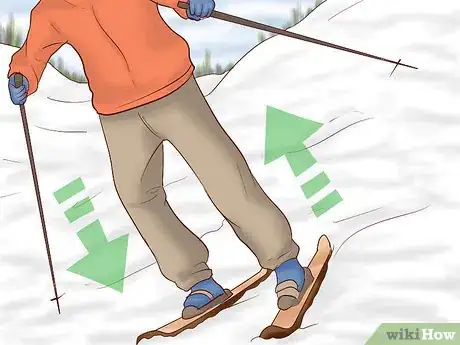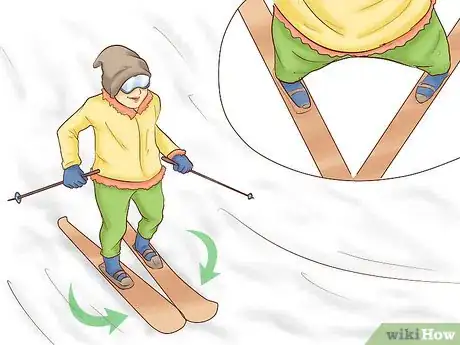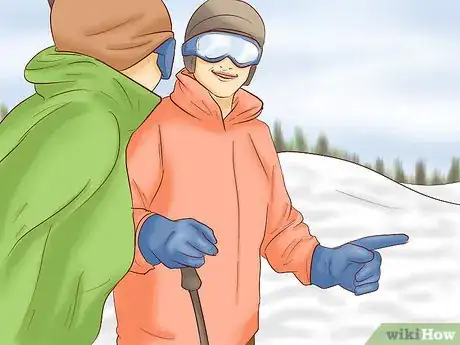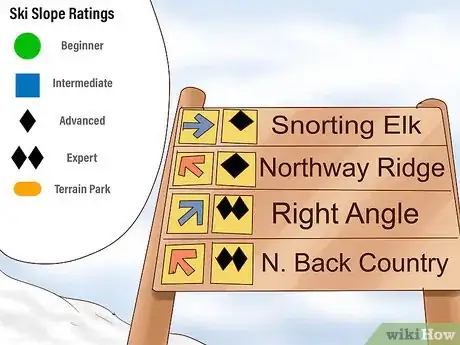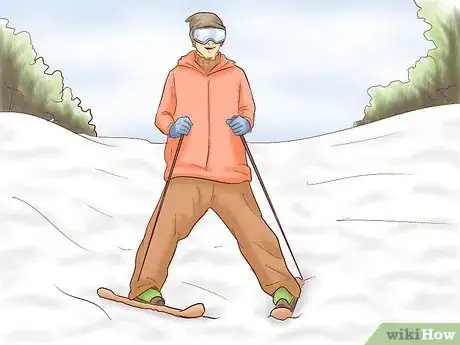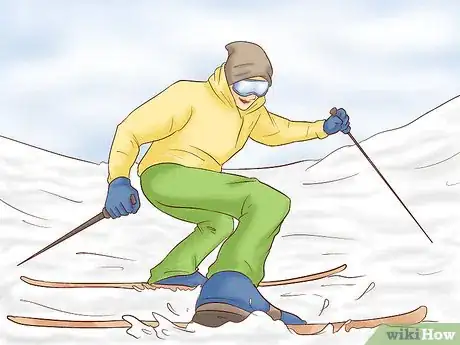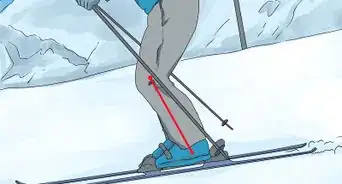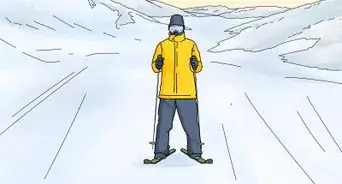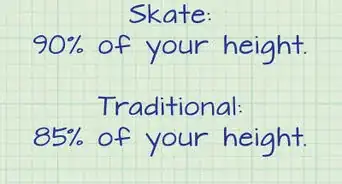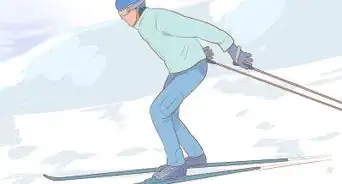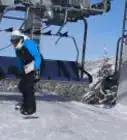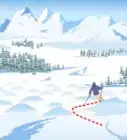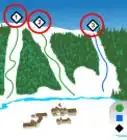This article was co-authored by Kent Bry. Kent Bry is a certified ski and snowboarding instructor and the director of Adventure Ski & Snowboard, a school based in the San Diego, California metro area. With over 50 years of skiing and snowboarding performance and instruction experience, Kent is certified by the Professional Ski Instructors of America (PSIA). Adventure Ski & Snowboard is a member of the PSIA and the American Association of Snowboard Instructors (AASI). Kent holds a BS in Recreational Therapy from San Diego State University and is also a California-registered recreational therapist.
There are 7 references cited in this article, which can be found at the bottom of the page.
This article has been viewed 142,895 times.
Skiing is a hobby loved by many people, but it can be dangerous if you jump in without the proper equipment and skills. Choose skis, boots, and poles that fit your height. Get into your stance with feet hip width apart and knees bent. Learn to turn and stop by taking lessons from a ski instructor. Check the slope ratings and stick to the beginner slopes, go slow at first, and always stop before you are at the bottom of the hill.
Steps
Equipment
-
1Pick skis that are shorter than you. Look at a ski size chart to see what size you should get ahead of time. You can also stand the skis on their end and pick ones that are about 13cm (5 inches) shorter than you. Shorter skis are easily to learn on than long skis.[1]
- The longer the skis are that you choose are, the more finesse it will take to slow down and turn because you have more ski to move.
-
2Make sure the boots are tight and do not slip around. Try ski boots on while wearing ski socks, as these are thicker than normal socks. When you first put your boots on, your toes may feel crunched, but this is normal and it will go away. Once the boots are strapped up, you should be able to barely wiggle your toes but your whole foot should be secure.[2]
- Ski boots should be tight but not to such a point that your feet are uncomfortable. There is a fine line between the perfect fit and boots that are too small.
- Ski boot sizes are not directly related to sneaker sizes. You should ask an employee at the ski park to assist you with choosing the right boots.
- Make sure you can walk around in the boots without your calves feeling pinched.
Advertisement -
3Grab a set of poles. Ski poles are used to help you balance and turn. Choose a set of poles that come roughly to your ribs or chest. Find poles that have grips you are comfortable with.
- Skis.com has a chart for pole length depending on skier height[3]
- Note that most ski resorts teach kids to ski without poles. They aren't necessary for beginners, and are an awkward accessory when beginning to ski. That being said, it may help to get used to them sooner, but they can be easily lost.
-
4Choose warm but breathable clothes. Wear layers but avoid clothes that are too bulky. You are still exercising, so you will probably sweat. The exact amount or type of clothes is personal preference.
- Wear a tight polyester t-shirt that is breathable as your base layer. Wear a fleece or polyester mid-layer that will keep you warm. Your top layer should be a waterproof jacket, if possible, but not a bulky one that restricts movement.
- For pants, you might wear long underwear with waterproof snow pants on top.
- Wear warm, wool socks that are comfortable on your feet.
-
5Wear a helmet and gloves. Skiing can make you cold for two reasons. The temperature on ski slopes tends to be low anyway given the fact that there is snow on the ground. You are also racing through the air at high speeds which makes you colder. Choose a helmet and gloves that fit snug on your head and hands.
- Wear waterproof gloves if you can because you might fall and get snow on them.
- Wear a balaclava that completely covers your head and fits well.
- Wear a helmet over the balaclava to protect your skull from things you might run into. Some ski places may offer helmet rentals.
- You may also choose to wear a hat, but some ski resorts may require helmets for terrain parks. Hats are generally not as popular as they used to be, because of the increased awareness for head injuries.
-
6Protect yourself. Wear goggles to protect your eyes from wind burn and to protect your eyes from sunburn. A whole day of wind blowing in your eyes can cause harm to them. Despite the cold, it is possible that you’ll get sunburn from the glare off of the snow. Wear sunscreen to protect your face. Helmets are also a good idea to protect your head in case you fall.
Stance
-
1Set your feet hip-width apart. The basic stance for skiing, especially for a beginner, is to keep your legs in line with your hips. As you get the feel on the slopes, you can move your feet farther apart or closer together. Keep your skis mostly parallel but with your toes pointed slightly inward.[4]
-
2Bend your knees. Skiing uses the same basic athletic stance as most other sports. It is important to bend your knees because it improves your balance and it helps you take on the impact of bumps in the slope.
- Your ski boots will restrict how much you can bend your knees, but you only need to bend them slightly.
-
3Keep a centered and balanced stance. Move your weight onto the balls of your feet. Stay off your heels and resist leaning back. You will be leaning forward since your body is angled down the slope, but don’t lean too far forward. Keeping your balance centered on your feet will keep you going straight.
- Leaning left or right will make you turn and leaning too far forward or backward will throw your balance off, causing you to fall.
Basic Skills
-
1Turn by lifting the ski on the side you want to turn toward. There are a number of ways to turn, but one of the simplest is to lift one ski just off of the snow. This will turn your body in that direction. So if you want to turn to the left, slightly lift your left ski. If you want to turn right, slightly lift your right ski.
- Also turn by twisting your hips in the direction you want to go. Twisting your hips will turn your skis in the direction you want to go.
- You can also try pushing down harder on the ski opposite to the direction you want to turn. To turn left, push down on the right-side ski, and the edges of your skis will turn you.
-
2Stop by pointing your toes toward each other. The simplest stopping technique is the wedge or snowplow method. Turn the front tips of your skis so they are close together, and the back tips are far away from each other, a shape like a slice of pizza or a wedge. To stop completely, get the back of your skis as far apart as you can without having the front tips touching each other.[5]
- Point your toes toward each other gradually. If you point your toes together with a quick movement you are likely to throw off your balance.
- Practice stopping from slow speeds until you get the hang of it.
- How early you slow down depends on how long the hill is and how fast you are going. For small hills, you should slow down in the last 20 yards or so. On larger hills at higher speeds, look to slow down in the last 20% of the hill.
-
3Take a ski lesson. Doing online research is great, but nothing beats having an instructor to give you specific instruction and feedback. Sign up for lessons before you get to the ski resort or ask about beginner classes when you arrive.[6] [7]
- You may have the option of group classes with other beginners or private lessons, which usually cost more.
First Run
-
1Learn about slope ratings. Ski parks post signs that tell you the difficulty level of each slope so you can stick to runs that fit your skill level. Look for signs at the ski park you are at to see what system they use.
- Common slope ratings go from green circle (easy) to black diamond (hard).[8]
- If you can’t find a sign with slope ratings, don’t be afraid to ask an attendant what the rating system is or what some good slopes are for beginners.
-
2Go slow while you get the hang of it. You will not be an expert on your first run, so don’t try to tackle the biggest slopes in record speed when you start skiing. Use the wedge or snowplow technique to keep yourself moving at a slow speed until you master slowing, turning, and stopping.
- Stop on the hill if you feel like you are picking up too much speed. You can start again and finish the hill. Be sure that you stop on the side of the trail, so other people can avoid running into you.
-
3Start slowing down before you get to the bottom. Coming to a complete stop is one of the harder things to get used to when you begin skiing. To keep yourself and others safe, practice stopping long before you get to the very bottom of the hill.
Expert Q&A
-
QuestionWhat tips do you have for someone who is nervous to ski?
 Kent BryKent Bry is a certified ski and snowboarding instructor and the director of Adventure Ski & Snowboard, a school based in the San Diego, California metro area. With over 50 years of skiing and snowboarding performance and instruction experience, Kent is certified by the Professional Ski Instructors of America (PSIA). Adventure Ski & Snowboard is a member of the PSIA and the American Association of Snowboard Instructors (AASI). Kent holds a BS in Recreational Therapy from San Diego State University and is also a California-registered recreational therapist.
Kent BryKent Bry is a certified ski and snowboarding instructor and the director of Adventure Ski & Snowboard, a school based in the San Diego, California metro area. With over 50 years of skiing and snowboarding performance and instruction experience, Kent is certified by the Professional Ski Instructors of America (PSIA). Adventure Ski & Snowboard is a member of the PSIA and the American Association of Snowboard Instructors (AASI). Kent holds a BS in Recreational Therapy from San Diego State University and is also a California-registered recreational therapist.
Certified Ski & Snowboarding Instructor
-
QuestionHow can I avoid injuries on the slopes?
 Kent BryKent Bry is a certified ski and snowboarding instructor and the director of Adventure Ski & Snowboard, a school based in the San Diego, California metro area. With over 50 years of skiing and snowboarding performance and instruction experience, Kent is certified by the Professional Ski Instructors of America (PSIA). Adventure Ski & Snowboard is a member of the PSIA and the American Association of Snowboard Instructors (AASI). Kent holds a BS in Recreational Therapy from San Diego State University and is also a California-registered recreational therapist.
Kent BryKent Bry is a certified ski and snowboarding instructor and the director of Adventure Ski & Snowboard, a school based in the San Diego, California metro area. With over 50 years of skiing and snowboarding performance and instruction experience, Kent is certified by the Professional Ski Instructors of America (PSIA). Adventure Ski & Snowboard is a member of the PSIA and the American Association of Snowboard Instructors (AASI). Kent holds a BS in Recreational Therapy from San Diego State University and is also a California-registered recreational therapist.
Certified Ski & Snowboarding Instructor Allow at least six feet of space around you. You don't want to ski too close to someone. Always call out if you're coming up behind someone, like "On your left" or "On your right," so you don't run into them. Also, make sure you're not skiing on a hill that's beyond your comfort zone.
Allow at least six feet of space around you. You don't want to ski too close to someone. Always call out if you're coming up behind someone, like "On your left" or "On your right," so you don't run into them. Also, make sure you're not skiing on a hill that's beyond your comfort zone. -
QuestionHow can I get over my fear of heights while on the steep, green-level slopes?
 Tanner McCartyCommunity AnswerFacing your fear can help you conquer it, so maybe you need to just start skiing down the slope. It can also help to start on the smallest hills and build up to the steeper ones.
Tanner McCartyCommunity AnswerFacing your fear can help you conquer it, so maybe you need to just start skiing down the slope. It can also help to start on the smallest hills and build up to the steeper ones.
Warning
- Make sure you are confident on your skis before you move up to the intermediate difficulty hills.
- Skiing can cause injuries, so always practice caution.
Things You'll Need
- Skis
- Ski Boots
- Poles
- Warm Clothes
- Helmet (optional)
References
- ↑ https://www.evo.com/guides/how-to-choose-skis-size-chart
- ↑ http://www.ultimate-ski.com/features/useful-ski-tips/your-first-ski-trip.aspx
- ↑ https://www.skis.com/Size-Charts-for-Ski-Poles/size-chart-12-23-2010,default,pg.html
- ↑ http://www.mechanicsofsport.com/skiing/basic_mechanics/stance.html
- ↑ http://www.mechanicsofsport.com/skiing/how_to_ski/snowplough.html
- ↑ http://blog.liftopia.com/5-tips-new-skiers/
- ↑ Kent Bry. Certified Ski & Snowboarding Instructor. Expert Interview. 14 July 2020.
- ↑ Kent Bry. Certified Ski & Snowboarding Instructor. Expert Interview. 14 July 2020.
About This Article
If you've never been skiing before, there are some things you should know and do beforehand so you feel more prepared and confident when you hit the slopes. First, you'll want to make sure you wear warm but breathable clothes, gloves, goggles, and a helmet. All of these are musts in addition to your skis, ski boots, and poles. Once you're on the slopes, you'll want to keep your feet hip-width apart, bend your knees slightly, and keep your balance centered so you're not leaning too far back or forward. When you need to turn, lift the ski on the side you want to turn toward. When you need to stop, gradually point your toes toward each other. If you're able to, it's always a good idea to take a ski lesson so you can get in-person instruction and feedback. For more beginner ski tips, check out the full article below!
